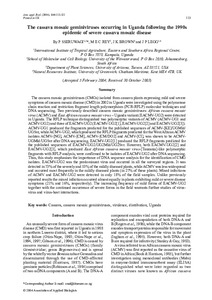| dc.contributor.author | Sseruwagi, P. |
| dc.contributor.author | Rey, M.E.C. |
| dc.contributor.author | Brown, J.K. |
| dc.contributor.author | Legg, J.P. |
| dc.date.accessioned | 2019-12-04T11:23:57Z |
| dc.date.available | 2019-12-04T11:23:57Z |
| dc.date.issued | 2004-08 |
| dc.identifier.citation | Sseruwagi, P., Rey, M.E.C., Brown, J.K. & Legg, J.P. (2004). The cassava mosaic geminiviruses occurring in Uganda following the 1990s epidemic of severe cassava mosaic disease. Annals of Applied Biology, 145(1), 113-121. |
| dc.identifier.issn | 0003-4746 |
| dc.identifier.uri | https://hdl.handle.net/20.500.12478/4221 |
| dc.description.abstract | The cassava mosaic geminiviruses (CMGs) isolated from cassava plants expressing mild and severe symptoms of cassava mosaic disease (CMD) in 2002 in Uganda were investigated using the polymerase chain reaction and restriction fragment length polymorphism (PCR-RFLP) molecular techniques and DNA sequencing. Two previously described cassava mosaic geminiviruses: African cassava mosaic virus (ACMV) said East African cassava mosaic virus - Uganda variant (EACMV-UG2) were detected in Uganda. The RFLP technique distinguished two polymorphic variants of ACMV (ACMV-UG1 and ACMV-UG2) and three of EACMV-UG2 (EACMV-UG2[1], EACMV-UG2[2] and EACMV-UG2[3]). ACMV-UG1 produced the fragments predicted for the published sequences of ACMV-[KE]/UGMld/ UGSvr, while ACMV-UG2, which produced the RFLP fragments predicted for the West African ACMV isolates ACMV-[NG], ACMV-[CM], ACMV-[CM/DO2] and ACMV-[CI], was shown to be ACMV-UGMld/UGSvr after DNA sequencing. EACMV-UG2[1] produced the RFLP fragments predicted for the published sequences of EACMV-UG2/UG2Mld/UG2Svr. However, both EACMV-UG2[2] and EACMV-UG2[3], which produced East African cassava mosaic vzras-[Tanzania]-like polymorphic fragments with RFLP analysis, were confirmed to be isolates of EACMV-UG2 after DNA sequencing. Thus, this study emphasises the importance of DNA sequence analysis for the identification of CMG isolates. EACMV-UG2 was the predominant virus and occurred in all the surveyed regions. It was detected in 73% of the severely and 53% of the mildly diseased plants, while ACMV was less widespread and occurred most frequently in the mildly diseased plants (in 27% of these plants). Mixed infections of ACMV and EACMV-UG2 were detected in only 18% of the field samples. Unlike previously reported results the mixed infection occurred almost equally in plants exhibiting mild or severe disease symptoms (21% and 16%, respectively). The increasing frequency of mild forms of EACMV-UG2 together with the continued occurrence of severe forms in the field warrants further studies of virus-virus and virus-host interactions. |
| dc.description.sponsorship | Department for International Development, United Kingdom |
| dc.language.iso | en |
| dc.subject | Cassava |
| dc.subject | African Cassava Mosaic Virus |
| dc.subject | Germinuviruses |
| dc.subject | Virulence |
| dc.subject | Distribution |
| dc.title | The cassava mosaic geminiviruses occurring in Uganda following the 1990s epidemic of severe cassava mosaic disease |
| dc.type | Journal Article |
| dc.type | Journal Article |
| dc.description.version | Peer Review |
| cg.contributor.crp | Roots, Tubers and Bananas |
| cg.contributor.affiliation | International Institute of Tropical Agriculture |
| cg.contributor.affiliation | University of the Witwatersrand |
| cg.contributor.affiliation | University of Arizona |
| cg.coverage.region | Africa |
| cg.coverage.region | East Africa |
| cg.coverage.country | Uganda |
| cg.isijournal | ISI Journal |
| cg.authorship.types | CGIAR and developing country institute |
| cg.iitasubject | Cassava |
| cg.iitasubject | Plant Diseases |
| cg.accessibilitystatus | Limited Access |
| local.dspaceid | 99787 |
| cg.identifier.doi | https://doi.org/10.1111/j.1744-7348.2004.tb00366.x |

